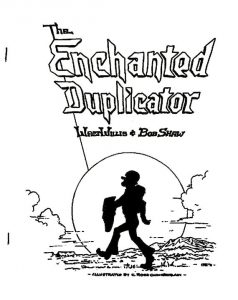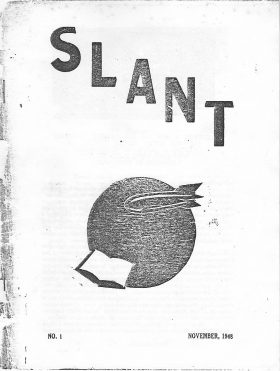
Walter Willis and Bob Shaw, The Enchanted Duplicator, fanzine, 1954.
Jophan and his Shield of Umor
Introduction
The Enchanted Duplicator was first published in February 1954. It was written as a collaboration by Walter A Willis and Bob Shaw. It has been re-issued at least ten times by as many different publishers. Such lasting popularity in a piece of amateur writing demands explanation. Here is what Willis himself had to say of it in Ethel Lindsay's fanzine Scottische 38 in 1965:
"The Enchanted Duplicator was received by fandom with such awe-inspiring enthusiasm that it must obviously have filled some deep-felt want for a new basis for our hobby, now that our former proselytising zeal for science fiction no longer seemed to make sense. More surprisingly it was warmly welcomed by people like Ken Slater and the new generation of serious-constructive fans . . . whose attitude it has criticised by implication."
"If you are really interested, Bob Shaw wrote most of Chapter 5 and 6, part of 7, and the first para of 17, but the idea itself is a much closer collaboration. It arose out of a conversation two years ago about a radio play by Louis MacNeice based on the quotation 'Childe Roland to the Dark Tower Came'. We kicked the idea around for a whole evening, ending with a pageful of notes. I wrote the first four chapters almost immediately and passed them on to Bob. That was the end of it for more than a year. Then when Vince ((A. Vincent Clarke)) was over last September we had a discussion about the sad state of Fandom at the time -- at that period Seventh Fandom was howling alone in the wilderness -- and put TED high on the list of Projects to promote a fannish revival. Like the new Hyphen and Toto. George Charters offered to cut the stencils, and every Tuesday afternoon I'd scribble a chapter or so in the office, type it out at teatime, and given it to George that evening. At one time I thought I'd never get it finished, because new ideas kept coming to mind more rapidly than the story progressed to a conclusion, and finally I'm afraid I cut it short too abruptly. There was to have been an Ultimate Temptation, science fiction itself, but I found it difficult to symbolise the exact shade of action representing the True Fan attitude to sf; and there was difficulty or plain impatience -- I was no longer quite so enthusiastic, having lived with the thing for eighteen months -- I just brought it to a close with that purple passage. Which I felt quite uneasy about at the time as perhaps having gone too far." (From a letter to Redd Boggs, March 1954.)Flawed or otherwise, The Enchanted Duplicator has since become a significant (if often unstated) part of the subsoil of fannish history. Although it addresses itself to the fandom surrounding its creation, its voice has carried down the years to touch the lives of fans unborn in 1954. Despite the generations, it still relates to something in the fannish heart.
I said that it addresses the fandom of its creation. Strip away the pseudonyms and this becomes plainer. The Circle of Lassitude is the London SF Circle of the early 50's. Kerles is Max Keasler, a fan noted for his typos. Perfexion is the above-mentioned Vincent Clarke. Profan's inspiration was Eric Frank Russell, whom Willis held in profound admiration. Offset printing is the folly of spendthrift fen, while photocopiers did not exist and are therefore not mentioned. Mimeography -- stencil duplicating -- was the fannish medium, not because of snobbishness but because it was the most convenient and immediately accessible means of getting words into print without breaking one's pocketbook.
Incidentally, Scrabo Tower, near Willis's present home in Northern Ireland, was the original model for the Tower of Trufandom.
The Enchanted Duplicator is more than a simple fairy tale about one fan's slow progress into the heartland of 'Fandom'. It contains practical advice on the pitfalls awaiting the new fan, puns wherever they could be fitted in, and it is a somewhat distorting window into a past era of fandom. But as well as all this, it is an allegory and a fable. A moral is not stated: it is implicit in every page. Simply: anyone may become a 'True Fan', but only by their own efforts. However, a sense of humour and a willingness to get along with other fans is essential.
The two halves of this moral are a reflection of Willis's own views. "There's nothing worth the wear of winning, but laughter and the love of friends" runs a quotation in the flyer produced in 1987 to mark the imminent publication of Hyphen 37 (a special issue to mark the 40th anniversary of 'Irish Fandom'). 'Not taking yourself seriously is the only serious way to deal with life' is a quotation in Hyphen 37. So much for the second half of the moral. The first half runs through all of Willis's writings. It is not enough to be easy-going and possess a sense of humour: you must be willing to go out and slog away at whatever projects you see as worth doing. Sycofan in The Enchanted Duplicator is, from Willis's viewpoint, a truly sick fan, not just a grovelling sycophant. Willis's contempt for those who lean too heavily on others is very plain in Chapters 10 and 14, and his impatience with loafers comes out in Chapter 8. Nevertheless, those who push too single-mindedly towards their goal, allowing the Shield of Umor to dull, risk dying in the desert or wandering into the Glades of Gafia. Neither should offers of help and fellowship from fellow fans be lightly refused. Fandom is not a pile of rotting paper and rugged individuals, but a community. I would compare it to a tree, with roots, trunk, and branches as its past and supporting framework, and the leaves as today's generation of fen; the physical expression of an Idea. Every time a new leaf (=fan) appears, the Idea is nurtured and grows. When fans fall out it is weakened and damaged, and if enough fans fall out at once then the Idea dies. (Obviously the analogy is to an evergreen, not deciduous tree!)
The tree is you, me, and that fan over there. For although TED was written for what are today referred to as 'fanzine' fans, it is true for other expressions of fandom. It is what we make of it.
This version of The Enchanted Duplicator closely follows the text of the original 1954 edition, taken from a photocopy kindly provided by A. Vincent 'Perfexion' Clarke. The only deliberate changes involve minor smoothing of the typography and punctuation. Even instances of inconsistant case (as with 'fairy' and 'Fairy') in the original have been preserved.
| Illustration | A Map of Jophan's Journey |
| Chapter 1 | In Which The Spirit Of Fandom Appears To Jophan |
| Chapter 2 | In Which Jophan Starts On His Journey |
| Chapter 3 | In Which Jophan Tarries In The Circle Of Lassitude |
| Chapter 4 | In Which Jophan Meets A Traveller From Fandom |
| Chapter 5 | In Which Jophan Enters Fandom |
| Chapter 6 | In Which Jophan Ventures Into The Jungle Of Inexperience |
| Chapter 7 | In Which Jophan Encounters The Denizens Of The Jungle |
| Chapter 8 | In Which Jophan Meets Two Strange Neofen |
| Chapter 9 | In Which Jophan Encounters The Hucksters |
| Chapter 10 | In Which Jophan Comes To The City |
| Chapter 11 | In Which Jophan Learns The Truth About The City |
| Chapter 12 | In Which Jophan Finds A Friend |
| Chapter 13 | In Which Jophan Recruits Native Bearers |
| Chapter 14 | In Which Jophan Starts Across The Desert Of Indifference |
| Chapter 15 | In Which Jophan Enters The Region Of Oases |
| Chapter 16 | In Which Jophan Enters The Canyon Of Criticism |
| Chapter 17 | In Which Jophan Continues Through The Canyon |
| Chapter 18 | In Which Jophan Reaches The End Of His Journey |
Walter Willis and Bob Shaw, Beyond the Enchanted Duplicator to the Enchanted Convention, fanzine, 1991.
download: http://fanac.org/fanzines/Beyond_Enchanted/

Walter Willis, Slant, fanzine, 1948-1953.
Slant was the first fanzine published by Walt Willis in collaboration with James White as Art Editor. It ran from 1948 until 1953 with seven issues and immediately established Willis as a fanwriter of note. In 2004 it won the 1954 Best Fanzine Retro Hugo and was nominated for the 1951 Best Fanzine Retro Hugo.
In addition to Slant, Willis also co-edited and wrote for Hyphen and was a regular columnist in Quandry and Warhoon. Willis also received a 1958 Hugo for Outstanding Actifan. He attended the 1952 Worldcon in Chicago as a special guest via funds raised by fans that lead to the establishment of the TransAtlantic Fan Fund. He also attended the 1992 Worldcon in Orlando, Florida as the Fan Guest of Honor.

Along with Bob Shaw and James White, the three were referred to as the Belfast Triangle. Those three with the addition of George Charters, Ian McAulay and John Berry were known as the Wheels of IF, representing the influential Irish Fandom.
You can read more about Willis in The Encyclopedia of Science Fiction and Fancyclopedia 3.
For your reading pleasure, you can find Slant here.
https://dublin2019.com/irish-fiction-fridays-walter-willis-slant/
Walter Willis and Bob Shaw, The Enchanted Duplicator

No comments:
Post a Comment
Note: Only a member of this blog may post a comment.